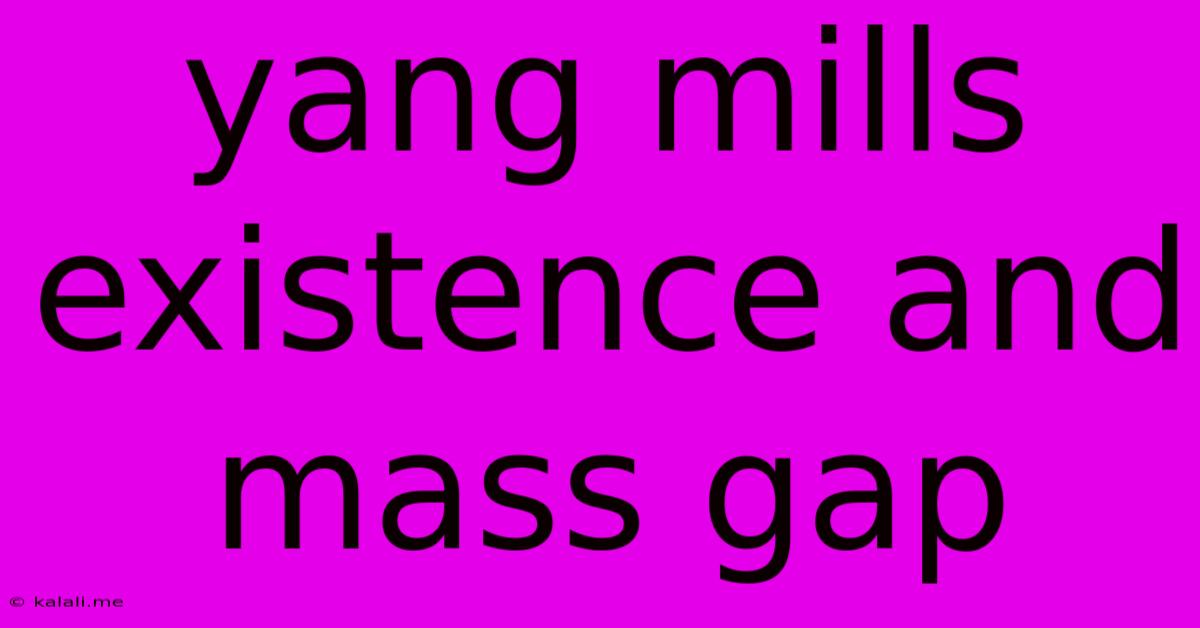Yang Mills Existence And Mass Gap
Kalali
Jun 09, 2025 · 3 min read

Table of Contents
The Yang-Mills Existence and Mass Gap: A Deep Dive into a Millennium Prize Problem
The Yang-Mills existence and mass gap is one of the seven Millennium Prize Problems posed by the Clay Mathematics Institute. This problem sits at the intersection of quantum physics and mathematics, specifically focusing on a fundamental aspect of quantum field theory: the behavior of Yang-Mills theories and the existence of a mass gap. Understanding this problem is crucial for a more complete understanding of the strong nuclear force and the fundamental constituents of matter. This article provides an overview of the problem, its significance, and the challenges faced in solving it.
What are Yang-Mills Theories?
Yang-Mills theories describe fundamental interactions in particle physics, like the strong and weak nuclear forces, using non-Abelian gauge fields. These theories are based on the concept of gauge invariance, which essentially means that the physics should remain unchanged under certain transformations. Unlike electromagnetism (described by the Abelian U(1) gauge theory), Yang-Mills theories involve more complex symmetry groups, such as SU(2) for the weak interaction and SU(3) for the strong interaction (Quantum Chromodynamics or QCD). These theories are incredibly successful in predicting experimental results, but their mathematical foundations remain incompletely understood.
The Mass Gap Problem
The core of the Yang-Mills existence and mass gap problem revolves around the concept of a "mass gap." In quantum field theories, particles are excitations of the underlying quantum fields. In Yang-Mills theories, the gluons – the force carriers of the strong interaction – are massless in the classical theory. However, experimentally, we observe that hadrons (like protons and neutrons), which are bound states of quarks held together by gluons, possess a non-zero mass. This difference between the massless gluons and the massive hadrons is what's referred to as the "mass gap."
The problem is to rigorously prove that:
- Existence: Yang-Mills equations have a unique, non-trivial solution that describes the physical world. This requires establishing the existence of a well-defined quantum field theory that satisfies the axioms of quantum field theory.
- Mass Gap: This solution exhibits a mass gap; meaning there's a minimum energy above the vacuum state, leading to the observed massive particles. This is crucial because it explains why hadrons have mass, despite the massless gluons.
Challenges and Current Approaches
Solving the Yang-Mills existence and mass gap problem presents significant mathematical challenges. The non-linearity of the Yang-Mills equations makes them exceptionally difficult to solve analytically. Perturbative methods, which work well for weakly interacting theories like Quantum Electrodynamics (QED), fail in the low-energy regime of QCD where the strong coupling constant becomes large.
Researchers are exploring various approaches, including:
- Constructive Quantum Field Theory: This approach focuses on rigorously constructing the quantum field theory from its fundamental axioms, often using lattice gauge theory techniques. Lattice gauge theory discretizes spacetime, allowing for numerical simulations and approximate solutions.
- Functional Analysis: Advanced techniques in functional analysis are employed to analyze the properties of the Yang-Mills functional and its solutions.
- Non-perturbative methods: These methods attempt to tackle the strong coupling regime directly, circumventing the limitations of perturbative techniques.
Significance and Implications
A solution to the Yang-Mills existence and mass gap problem would have profound implications for our understanding of fundamental physics. It would:
- Solidify the mathematical foundations of QCD: Providing a rigorous mathematical framework for the theory of the strong nuclear force.
- Advance our understanding of confinement: Explain the mechanism by which quarks are confined within hadrons.
- Lead to breakthroughs in other areas of theoretical physics: Potentially providing insights into other unsolved problems in quantum field theory and beyond.
The Yang-Mills existence and mass gap problem remains one of the most challenging and significant problems in modern theoretical physics. While a complete solution is still elusive, ongoing research continues to shed light on the intricacies of Yang-Mills theories and promises further advancements in our understanding of the fundamental forces of nature. The pursuit of a solution represents a fascinating intersection of advanced mathematics and cutting-edge physics.
Latest Posts
Latest Posts
-
Is A Search Bar Considered A Widget Wordpress
Jun 09, 2025
-
Toilet Water Rises Then Slowly Drains How To Fix
Jun 09, 2025
-
Mac How To See Which Window Is Associated With User
Jun 09, 2025
-
How Deep Should My Fence Post Be
Jun 09, 2025
-
How Do I Cap Off A Sprinkler Head
Jun 09, 2025
Related Post
Thank you for visiting our website which covers about Yang Mills Existence And Mass Gap . We hope the information provided has been useful to you. Feel free to contact us if you have any questions or need further assistance. See you next time and don't miss to bookmark.